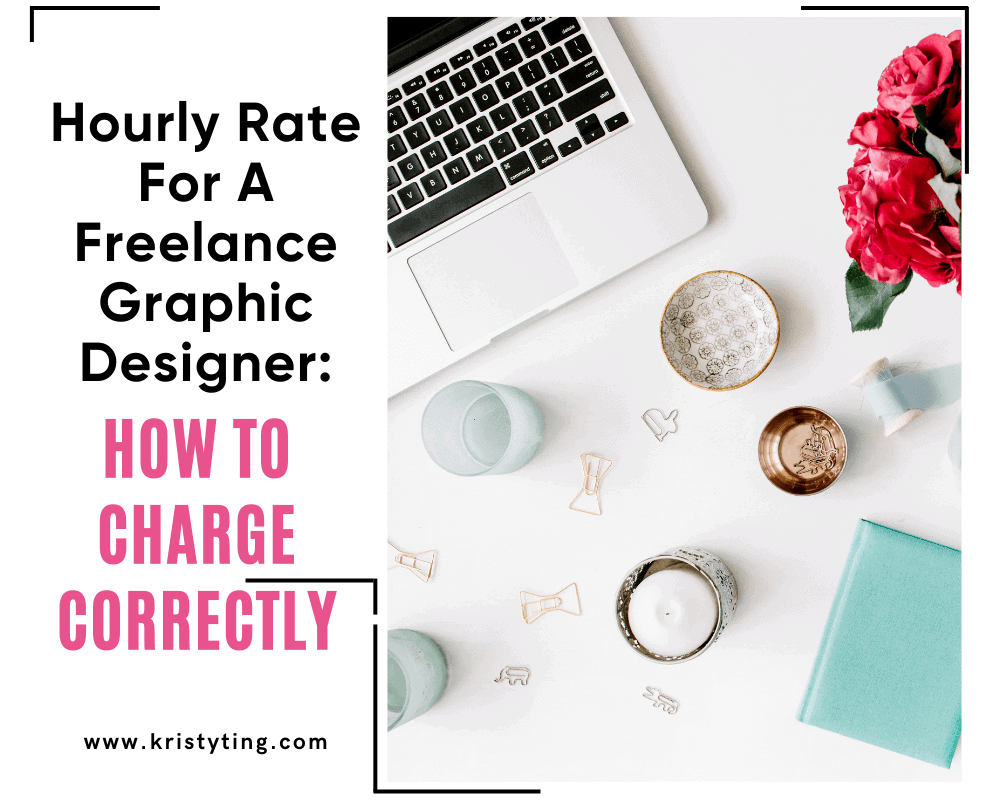This post may contain affiliate links. If you use these links to buy something we may earn a commission at no extra cost to you. Thank you for your support!
As the world moves towards a more digital era and the gig economy becomes a norm, the demand for skilled freelance graphic designers has increased significantly. Freelance graphic designers are professionals who use their creativity and technical skills to create visual designs for their clients. From creating logos to designing websites and social media posts, freelance graphic designers play a crucial role in the success of many businesses.
One of the most common questions that aspiring freelance graphic designers ask is how much they can earn as a freelancer. According to recent statistics, the average hourly rate for a freelance graphic designer in 2022 was $30. However, this figure varies depending on factors such as experience, location, years of experience and skill set.
To give you a better idea of what to expect, here are some hourly rates for freelance graphic designers according to reputable job search websites:
- Upwork: The average hourly rate for a freelance graphic designer on Upwork is $25.
- Indeed.com: The average hourly rate for a freelance graphic designer on Indeed.com is $31.
- Ziprecruiter: The average hourly rate for a freelance graphic designer on Ziprecruiter is $32.
- Payscale: The average hourly rate for a freelance graphic designer on Payscale is $29.
- Glassdoor: The average hourly rate for a freelance graphic designer on Glassdoor is $30.
It’s important to keep in mind that these freelance rates are just averages, and some freelance graphic designers earn much more than this depending on their expertise and experience. Additionally, many freelance graphic designers charge a flat rate for specific projects, rather than an hourly rate – more about that in a bit!
The popularity of freelance graphic design as a career is due to several factors. For one, freelance graphic design allows professionals to work on a variety of projects and clients, giving them the freedom to choose the projects that interest them the most. Additionally, freelance graphic designers have the flexibility to set their own schedules and work from anywhere, making it an attractive option for those who value work-life balance.
Freelance graphic design is a lucrative and popular career choice for creative professionals looking to use their skills to make a living. The hourly rates for freelance graphic designers vary depending on several factors, but with the demand for skilled graphic designers on the rise, there are plenty of opportunities to earn a great income in this field.
How Much Should A Beginner Or New Designer Charge?
As a beginner freelance designer, it can be challenging to determine how much to charge for your services. In fact, most freelancers still have a hard time determining the best way to charge for their graphic design services.
Fret not. After six months in service, you’ll be able to decide the type of work you are good at, the quality of work you can deliver, the standard freelance design rates other graphic designers are charging; and eventually the type of project pricing you’re comfortable with charging.
There are three main ways to charge clients: per hour, per project, and per retainer. Each method has its own pros and cons, so it’s important to consider which option is best for you and your business.
- Per hour: Charging per hour is a popular option for freelance graphic designers. This method involves billing clients for the actual time spent working on a project. The main advantage of charging per hour is that it allows you to be fairly compensated for the number of hours or time you spend on a project. However, it can be difficult to accurately estimate how long a project will take, and some clients may be hesitant to agree to an hourly rate.
As a beginner graphic designer, you can expect to charge between $20 to $50 per hour. However, as you gain more experience and develop a stronger portfolio, you may be able to charge as much as $100 per hour or more. - Per project: Charging per project involves providing clients with a flat rate for the entire project. This method can be beneficial because it allows you to give clients a clear idea of what they will be paying upfront. Additionally, charging per project can be a good option if you are confident in your ability to accurately estimate the time and resources required for each project. However, it can be challenging to accurately price a project, and you may end up spending more time than anticipated without being compensated for it.
Charging per project can range from a few hundred dollars for a basic project to several thousand dollars for more complex designs. For example, a simple logo design can cost between $250 to $500, while a website design can cost anywhere from $1,000 to $5,000. - Retainer: A retainer involves charging clients a set fee for a specified period of time, such as a month. This method can be beneficial because it provides you with a stable income stream and helps you build long-term relationships with clients. However, it may not be the best option if you are just starting out as a freelance graphic designer and don’t have a steady client base yet.
A retainer can range from a few hundred dollars per month for ongoing design work to several thousand dollars per month for more extensive services. The exact price will depend on the scope of the work and the length of the contract.
Generally, the standard method for finding out the type of hourly pricing you want to charge can easily be calculated by using the following formula:
Good hourly rate = Annual desired salary/Desired weeks of work/Desired amount of hours to work weekly
Example: If you were looking to make $70,000 annually, and have at least 3 weeks off in a year for vacations and family holidays, and only want to work 30 hours a week, then your hourly graphic designer rates would be:
70,000/49 weeks/30 hours = $47.60 per hour.
Overall, each method has its own advantages and disadvantages, and the best option for you will depend on your business goals and preferences. However, as a beginner graphic designer, it’s recommended to charge per project or hourly rates. Charging a retainer may not be the best option until you have established a steady client base. Ultimately, the most important thing is to charge a fair rate that reflects your experience, skills, and the time and effort you put into each project.
Average Freelance Graphic Design Rates By Project (Examples)
Here are the average freelance graphic design rates for project-based pricing:
- Standard logo design: The cost of a standard logo design can vary greatly depending on the experience level of the designer and the complexity of the design. On average, you can expect to pay anywhere from $250 to $2,500 for a logo design. This may include multiple revisions and file types for various uses.
- Basic website design: A basic website design may include a homepage, a few additional pages, and simple functionality such as contact forms or a blog. This type of project can cost anywhere from $1,000 to $5,000 on average. The cost will depend on the level of customization required and the amount of content that needs to be created.
- Ebook design: Ebooks have become an increasingly popular way to share information and knowledge online. The cost of designing an ebook can range from $500 to $2,000 on average. This will depend on the length of the book, the complexity of the design, and whether or not images or infographics are included.
- Social media graphics: Social media graphics are essential for any business looking to promote their brand and engage with their audience on platforms such as Instagram and Facebook. The cost of designing social media graphics can range from $50 to $300 per graphic on average. The price will depend on the complexity of the design and whether or not animations or videos are included.
- Business collateral: Business collateral can include items such as business cards, brochures, and flyers. The cost of designing business collateral can range from $200 to $1,500 on average. The price will depend on the amount of content required, the level of customization, and the number of revisions needed.
It’s important to note that these are just average rates, and prices can vary depending on the experience level, type of graphic design work required, estimated billable hours and location of the designer. Additionally, some designers may charge a flat rate for a specific project rather than an hourly rate. It’s always a good idea to get quotes from multiple designers and compare their rates and portfolios before making a decision.
Typically, there are different communities of graphic designers you can join (such as Facebook groups) that’ll have members who will happily share with you new rates, what to look out for when taking on new clients and project-based rates based on industry standards.
Factors To Take Into Consideration When Setting Your Rates
When setting your rates as a freelance graphic designer, there are several factors that you should take into consideration to ensure that you are fairly compensated for your work. Here are some factors to consider:
- Level of difficulty: Some projects may be more complex than others, requiring more time, skill, and creativity to complete. For example, designing a website with custom animations and features may be more difficult than designing a simple logo. It’s important to factor in the level of difficulty when determining your rates.
- Job scope: The scope of the project can also affect your rates. Projects that require more deliverables, revisions, and meetings may require more time and effort and should be reflected in your rates.
- Level of experience: As you gain more experience and expertise in your field, you may be able to charge higher rates. Clients are often willing to pay more for designers who have a proven track record of producing high-quality work.
- Estimated hours involved: It’s important to estimate the number of hours that will be required to complete a project and factor that into your rates. This will ensure that you are fairly compensated for the time and effort you put into each project. You may find this hard to estimate initially, but after a few projects, you’ll be able to decide accurately how much time you need to deliver great results.
- Overhead and expenses: It’s important to take into account the overhead and expenses associated with running a freelance business, such as equipment, software, office space, and marketing. These costs should be factored into your rates to ensure that you are covering your expenses and making a profit.
- Rush fees: Sometimes, some work may come in last minute and require you to put in more time, especially over the weekend. In such cases, adding an extra rush fee on top of the whole project pricing (such as $100 or $200 extra) will make it fair for both you and your client.
Ultimately, setting your rates as a freelance graphic designer involves finding a balance between being competitive in the market and being fairly compensated for your time and expertise. By considering factors such as level of difficulty, job scope, level of experience, estimated hours involved, overhead and expenses, you can ensure that you are setting rates that are both reasonable and profitable.
The Freelance Hourly Rate Calculator
I wanted to emphasize that while the above formula is quick and easy to use, there are other factors to take into consideration when calculating your hourly rate.
We mentioned overhead and expenses in the previous section.
Overhead and expenses can be categorized into two parts: General overhead expenses, and software and technology expenses.
General overhead expenses include calculations for taxes, health insurance (seeing as you’re not fully employed by a companyand do not have company insurance), phone bills, and more.
Software and technology expenses include the tools you’re using for design, such as Canva Pro paid subscription, Adobe Design, Figma, and more. We also talk about flat rate pricing, charging a day rate, other ways to charge.
Tips For Charging The Correct Hourly Rate As A Freelance Graphic Designer
Here are some tips for charging correctly and avoiding being underpaid and overworked:
- Be specific with your contract terms: It’s essential to have a detailed contract that outlines the scope of the project, the timeline, the deliverables, and the payment terms. This will help you avoid misunderstandings and ensure that you are fairly compensated for your work. Be sure to communicate any changes or additions to the contract in writing, and have both parties sign off on them.
- Stay relevant by constantly improving and learning: To stay competitive in the market and charge fair rates, it’s important to stay up-to-date with the latest design trends and technologies. Attend workshops, conferences, and online courses to improve your skills and expand your knowledge. This will help you offer more value to your clients and justify higher rates.
- Avoid undercharging to stay ahead of competitors: While it can be tempting to undercharge to win more clients, this can ultimately hurt your business in the long run. Undercharging can lead to overworking and burnout, and may attract clients who don’t value your work. Instead, focus on offering high-quality work and competitive rates that reflect your expertise and the value you offer.
- Always do research into every potential client before taking them on: Before accepting a new client, it’s important to research their business, their industry, and their budget. This will help you determine whether the project is a good fit for your skills and rates. Additionally, be sure to ask detailed questions about their expectations, deadlines, and budget to avoid any misunderstandings.
- Give a range, not a definite price. Always suggest a range of ballpark figures that gives the client an idea of how much budget they should set aside.
- Get your business cards ready. While preparing business cards may seem like a lot of work, they do a lot to catapult your status to one of a professional graphic designer, rather than just an online portfolio. It’s a great place to start when you’re making consistent income and want to scale to bring your freelance career to the next level. You can also send a business card online or promote it on your social media to promote your branding.
Increasing The Hourly Rate For A Freelance Graphic Designer
As creative freelancers become better at their art, get more potential clients and become in high demand, they naturally start to increase their own rates and graphic design prices. As you become better, you deliver great work while using less time. Higher end clients come knocking, bringing with them large budgets.
As a graphic designer, it’s important to regularly evaluate and adjust your rates to ensure that you are being fairly compensated for your skills and expertise. One key time to consider increasing your rates is when you have gained more experience and expertise in your field. If you have been freelancing for a while and have built a strong portfolio and client base, it may be time to consider raising your rates to reflect your growing value to clients. When increasing your rates, it’s important to communicate clearly with your clients and give them plenty of notice. Be sure to provide a detailed explanation for the rate increase, emphasizing the value you bring to the table and the benefits of continuing to work with you. Additionally, consider adjusting your rates for new clients while keeping current rates for existing clients to maintain good relationships. By regularly evaluating and adjusting your rates, you can ensure that you are earning a fair and sustainable income as a freelance graphic designer.
Seeing as the United States has different time zones, experienced graphic designers are usually right on bat when it comes to setting proper times for meetings and showing up. For example, the time zone in New York and San Francisco differ by 3 hours. Also, be alert to the time difference when you have potential clients from other countries.
By following these tips, you can ensure that you are charging correctly and avoiding being underpaid and overworked. By having a detailed contract, staying relevant, avoiding undercharging, and doing research into every potential client, you can set yourself up for success as a freelance graphic designer and business owner. The most important thing is to always stay consistent and try your best to get ongoing work. Even a complete website redesign can open doors to better opportunities – so don’t be picky!





